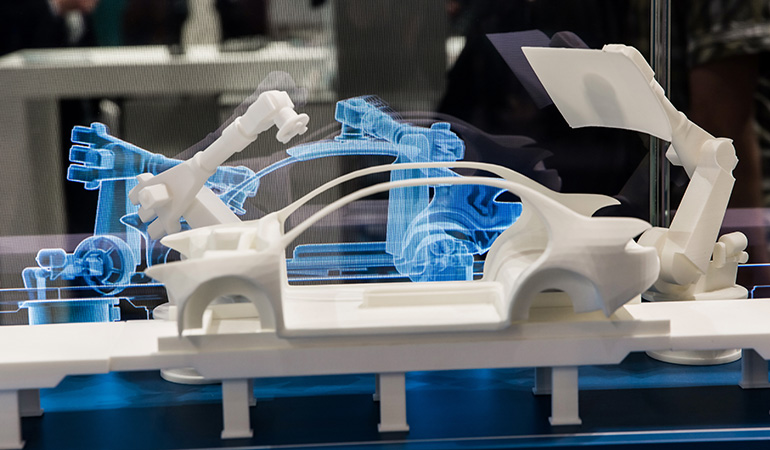Picture having the ability to digitally replicate any physical object, process, system, or environment. This is precisely what digital twin applications offer. They emerge as a potent tool for thriving in times of economic uncertainty, where businesses must innovate without the heavy burden of research and development costs to stay competitive.
These applications leverage IoT sensors, machine learning, cloud computing, mobility, and more to provide real-time insights into the state of your physical assets. Think about being able to predict the outcome of changes before you make them, avoiding costly disruptions to your operations.
Digital twin use cases span industries from aerospace and automotive to retail and energy, construction and logistics, healthcare, and insurance. Let’s explore the practical use of digital twins, helping businesses meet cost-efficiency and rise above the challenges of today’s economy.
Aerospace

NASA and Boeing are two prime examples that use the applications of digital twin. NASA has been twinning since the Apollo missions in the 1960s, where the engineers in the control center in Houston had a complete copy of the spacecraft at their disposal and could test any alterations on this twin model before advising the crew in flight.
John Wickers, a NASA executive and engineer, introduced the term “digital twin” back in 2010. At the time, the technology was immature, but the recent proliferation of ML/AI, IoT sensors, and cloud computing has made practical digital twin use cases possible.
Boeing uses digital twinning for a variety of purposes:
- Product design. Computer-aided design (CAD) models have long since replaced blueprints. Modern aerospace engineers can use digital prototypes of any equipment and system to test its performance before creating a single physical detail.
- Product development. Smart sensors attached to aircraft transmit data in near real time, replacing costly R&D testing with simulations.
- Crew training with AR/VR simulations. Digital twins enable rapid crew training both in civil aviation and in the Air Force. This dramatically decreases the risk of potentially disastrous newbie mistakes mid-flight.
- Maintenance and inspection. Technicians can also be quickly trained on mixed reality as-built models to minimize the risk of human factor mistakes when operating physical equipment.
- Sales and marketing. In-depth 3D models help clients easily explore the whole range of Boeing’s offers and select the aircraft modifications best suited to their needs.
According to Research and Markets survey results, 75% of aerospace industry executives state they are in different stages of implementing digital twin technology in their operations.
A practical use case: Boeing has safety limitations for carrying no more than 79,000 kilograms of cargo on average in its 737-800 model. The Challenge Advisory company decided to explore how much above the average this weight can go. Using digital twin technology, they were able to increase that limit by 23% safely — which is a huge deal for all airlines flying these vessels.
Architecture and design
The same principle applies here — creating conceptual architecture designs using digital twin tools enables architects and engineers to thoroughly test and predict the performance of a real-world building before the first brick is laid. Most importantly, a digital twin application creates a collaborative environment where stakeholders can easily visualize their ideas and get real-time feedback so the whole team is on the same page.
After the building is constructed, the facility management begins, and this is where digital twins shine again. By continuously exchanging data with their physical twin, digital models can highlight any discrepancy in operations, thus simplifying maintenance and reducing the risk of costly outages or crashes.
An example is the urban architectural project — Suzhou Center, where architects and developers harnessed digital twin innovation to simulate complex structural behavior, optimize energy usage, and monitor environmental factors. This resulted in a sustainable and visually stunning building.
Automotive industry
Similarly, digital twinning of vehicle parts and systems helps shorten the design cycle, speed up the development of new models, simplify driver and technician training, and ease maintenance. However, the key advantage of digital twins usage in the automotive industry lies in identifying and addressing potential issues before they arise, saving OEMs a ton of time and money.
Let’s take a look at digital twin use cases in the automotive industry and how they help achieve this result:
- 3D car designing and development. Testing new systems and modules on digital twins helps avoid costly rearrangement of assembly lines.
- Autonomous driving simulations. Testing autonomous systems and predicting the outcomes within the safety of the digital environment.
- Training and guidance. Drivers, assembly line workers, and car shop technicians can benefit from digital training in car systems assembly and maintenance. Virtual training helps gain and retain the needed knowledge better.
- Predictive analytics. Comparing the real-world data input from the IoT sensors in vehicles to the datasets within the digital twin can help predict failure at the first sign of variance, so a timely replacement of a car part or system adjustment can be made.
- Sales and marketing. Photorealistic renders and interactive car configurators can enable every client to visualize their dream car.

Source: MDPI
These automotive use cases highlight a silent revolution in the automotive industry happening right now. Digital twins enable OEMs to simulate and emulate the car’s behavior in different road conditions, form detailed response scenarios, and better train autonomous driving algorithms to minimize the risk of crashes on the road.
The advantages of this are so enormous that all major OEMs are racing to reap the benefits. BMW, Mercedes, Volvo, GE, and Toyota have heavily invested in integrating digital twinning into their workflows when creating electric and autonomous vehicles. As a result, the global value of the digital twin market is expected to grow from $9.5 Bn in 2022 to $72+ Bn in 2032, growing at a CAGR of 22.5% annually, according to a Future Market Insights forecast. The automotive industry will account for at least 15% of the market share.
Construction
Before the introduction of digital twins, much of the BIM (building information modeling) data was inaccessible at construction sites. However, with digital twin applications in construction, it becomes accessible through any mobile device. This simplifies communication between the office and the construction site, allowing stakeholders to address design inconsistencies in real time, preventing costly rework.
All in all, combining digital twins with BIM and AR enables much safer and smoother construction, on top of promoting its sustainability and reduces the need for costly reworks, as potential issues can be flagged and addressed promptly.
Energy and utilities

Running energy and utility facilities becomes much easier with digital twins. As this infrastructure gets increasingly equipped with smart sensors, it provides a ton of insights to ensure data-driven decision-making, timely adjustments, and optimal resource allocation.
Here are some digital twins use cases in the energy industry:
- Collaborative design visualization. Combining BIM with digital twins enables in-detail inspection of any facility, pipeline, pump station, or any other assets before being built. This allows timely project adjustments to reduce long-term expenses.
- Safe learning and training. Personnel operating these facilities can receive immersive training while the sites are under construction so they are ready to work efficiently and operate at full capacity from day one.
- Field service and maintenance. When field crews have access to detailed BIM models through their mobile devices and have all the information on hand, they can perform the initial analysis more efficiently and fix issues quickly.
- Site operations. Engineers can easily visualize information on all operations at any facility by remotely tracking the status of every physical asset. They can then make informed decisions based on the outcomes of in-depth emulations in near real time.
Energy and utility companies using digital twins can have a shared, cohesive, and collaborative environment, simplifying the management of their physical assets. This brings us to the practical implementation of the smart cities concept, which we will discuss below.
Smart cities and infrastructure
According to ABI Research, 500 digital urban twins are expected to be operational by 2025. Every city planning to attract investments and ensure a sustainable future for its inhabitants will benefit significantly from digital twin technology implementation.
Technological impact of digital twins on the smart city concept

Below are the most prominent use cases for infrastructure purposes and the smart city realm:
- Combining disparate data sets. Digital twins merge IoT data, geospatial sensors, historical data, and machine learning predictions to visualize the city. This aids policymakers in testing and optimizing resource allocation.
- Emulating traffic and pedestrian patterns. CCTV, IoT sensors, and other sources create data-driven models for city traffic and infrastructure. It helps pinpoint traffic jams’ sources and predict infrastructure optimization outcomes.
- Reducing waste and emissions. Combining data from various city departments creates a cohesive picture of city operations. It helps reveal inefficiencies and facilitates resource reduction and CO2 emission cuts.
This transformative technology empowers city officials and policymakers to gain invaluable insights into traffic flow patterns, identify potential infrastructure bottlenecks, analyze population mobility trends, and much more.
Government
Much like businesses harness the benefits of digital twin technology applications across their operations, governments too can leverage its potential to enhance their various functions.
As previously explored in sections covering use cases for construction, architecture and design, infrastructure and smart city management, as well as the automotive industry, a digital twin use case finds application in both private and governmental realms, making processes more efficient and data-driven
However, it’s crucial to spotlight additional ways in which governments can harness the power of digital twins:
- Emergency response planning. Digital twins can model disaster scenarios such as natural disasters, terrorist attacks, or pandemics.
- Environmental monitoring. Digital twins can help monitor and manage environmental factors such as air quality, water quality, and climate change.
- Government asset management. Digital twins can provide real-time insights into asset performance, maintenance needs, and lifecycle management.
- Smart agriculture. Governments can support the agricultural sector by using digital twins to monitor and optimize crop conditions, water usage, and pest control, contributing to food security.
In Germany, as an illustration of the latter, government authorities harness advanced surveying technologies such as LIDAR to analyze soil quality, examine flora conditions, and gauge the extent of agricultural activity or soil pollution.
In a nutshell, digital twins can help government agencies improve governance, deliver better public services, and enhance the quality of life for citizens.
Luxury branding and retail
The COVID-19 pandemic spurred luxury brands to transform their customer service. When brick-and-mortar branches were closed, online shopping remained the only option. Digital twinning enables the shopping experience on a whole other level — from live 3D configuration tools to virtual try-on experiences.
Luxury brands and retailers can benefit from digital twin tools through:
- Custom 3D product configurators. Enables customers to create truly unique apparel and accessories through flexible 3D configurator platforms.
- Virtual try-on. Combining artificial vision with digital twins helps give buyers confidence in their choices by letting them try on the goods online.
- Virtual showrooms. Enables customers to easily browse the brand’s offerings and create custom collections tailored to their unique tastes.
LVMH, a luxury conglomerate, used digital twins to create a virtual try-on experience. By combining artificial vision and digital twins, customers could try on luxury apparel and accessories virtually, gaining confidence in their choices.
Manufacturing

The digital twin applications in manufacturing are one of the prominent domains of digital twin implementation. As of now, 93% of industry leaders using AI in some form. Given the significant investment in high-cost, high-yield machinery for production, the manufacturing sector greatly profits from transparent and projectable product design, predictive maintenance, shop floor efficiency optimization, robotics, and edge analytics.
Below are the most widespread use cases in manufacturing:
- Predictive maintenance. Equipment and conveyor lines outfitted with intelligent IoT sensors can signal when a module is at risk of breaking. Timely replacement can prevent lengthy and costly production outages.
- Generative product design. Given the data on product purpose, composition, raw material and production costs, durability, and other factors, generative design software can deliver thousands of possible product designs, speeding up the R&D process.
- Shop floor performance. In non-fully Industry 4.0 factories relying on human operation, shop floor performance is crucial. Digital twins identify bottlenecks, test adjustments, and suggest optimal layouts using geospatial mapping.
A prime example shows how Siemens achieves higher precision, reduces costs, enhances quality, and provides more efficient power generation solutions to their customers by utilizing digital twins in gas turbine manufacturing.
- Robotics and employee training. VR/AR training of employees and warehouse robotics ensures efficient knowledge transfer.
- Edge Analytics. By deploying digital twins at the edge of the network, manufacturers can process data locally, reducing latency and enabling real-time decision-making.
Customizing digital twin models to suit each manufacturing facility’s unique setup remains challenging. However, ongoing developments in machine learning and artificial intelligence enable more adaptable and automated model creation.
Supply chain and logistics
Delivering products and materials on time with minimal expense is the fundamental goal of logistics. Supply chain operators must deal with price volatility, route disruptions, stock distribution, and optimal warehouse usage while tracking their fleet and ensuring it is in peak operational condition.
Digital twins can help jump over these hurdles by:
- Enriching the logistics network data. Logistics enhance efficiency by integrating fleet software with IoT sensors, cameras, and real-time data sources. This identifies congestion and underserved areas and suggests rerouting for warehouse optimization.
- Optimizing warehouse design. Often, warehouse management relies on the traditional approach. Equipping assets with smart sensors to track their routes can create much more efficient layouts and increase operational performance.
- Improved packaging utilization. Diversified packaging is crucial for efficient delivery of goods. Digital twins optimize material use, reducing quantities for safe delivery and yielding substantial consumable savings at scale.
The supply chain and logistics can benefit enormously from introducing digital twin technology separately. However, implementation as a part of a country-wide project and integration with smart city management projects can be even more beneficial.
Healthcare
Digital twins hold immense potential to transform patient care, research, and healthcare operations. Though still at its infancy, there are numerous use cases in healthcare when digital replicas can bring feasible breakthroughs on the way to safeguard humanity and prepare it for the next health crisis. As an example that showcases the fascinating use of technology replication of the immune system, paving the way for enhanced understanding, addressing immune-dependent conditions, and expediting drug discovery. Let’s directly explore several real-life healthcare use cases that harness the power of digital twins:
- Drug discovery and development. Pharmaceutical companies are turning to digital twins to model the effects of new drugs on virtual patients. The safety of clinical trials is the most important outcome, which comes with reduced costs and time.
- Personalized medicine. Digital twins can integrate patient medical histories, genetic data, and health metrics, enabling tailored treatments. They simulate outcomes and optimize therapeutic approaches for healthcare providers.
- Surgical training. Surgeons can use digital twins to rehearse surgeries on virtual patient models, allowing for better preparation and skill development.
- Enhanced imaging. Coupled with machine learning algorithms, digital twins aid in analyzing medical images, such as X-rays and MRIs. This results in improved diagnostic accuracy and reduced turnaround times.
Insurance
Deeply intertwined with healthcare, this industry can also benefit immensely from digital twin technology. Modern-day insurers must operate huge data sets to offer personalized and value-added services to their clients. Digital twinning helps create personalized customer experiences based on data, not guesswork. Combining these with data from other sources — real estate, healthcare, education, etc. — can provide valuable insights into the financial position and potential risks for every patient.
Depending on the specific sector, such as health, property, car insurance, or business insurance, digital twin applications within the industry yield diverse advantages. To illustrate, major insurance players like State Farm are actively investing in digital twin startups with a keen focus on telematics-based car insurance. This approach enables a more precise evaluation of driver behavior and the calculation of insurance premiums.
Real estate

Planning and designing, building structures and housing, installing the energy and utility grids, and managing the completed facilities, as described above, also apply in the commercial and private real estate sector. Additionally, renovation upon purchase is a factor for personal preferences or businesses that want to repurpose a facility to suit their operational needs better.
Using digital twin technology in real estate means the needed information is at your fingertips, allowing you to show clients how the systems operate currently and what adjustments can be made to existing structures. Having a simple visualization of possibilities can be a decisive factor in sealing a deal.
For instance, companies like Johnson Controls and Willow have come together to integrate their smart building and digital twin solutions, facilitating the digitization of real estate properties and facilities. More information about the initiative is here.
Intellias expertise in digital twin implementation
We are no newcomers to the digital twin field. Intellias has harnessed extensive expertise in digital twin development, offering insights on best practices, potential pitfalls, and successful use cases in supply chain, manufacturing, smart facility management, and automotive sectors.
Read also: Digital Twin in Facility Management
Through 20+ years of software engineering, we have become experts in all aspects of software delivery — from cloud service configuration to data engineering, machine learning, and designing in-depth solutions based on your specific business needs.
Intellias works both with Azure Digital Twins and the AWS Digital Twins platform; we shared our expertise in the field during the 2023 Digital Twin and Manufacturing Summit.
Recognized by Ernst & Young as the national choice for IT professionals and being on the IAOP top 100 global outsourcing list for five consecutive years, Intellias serves 100+ international partners in 14 locations worldwide. We’re confident we can solve software-related challenges of any nature, scale, and complexity.
Contact us to discuss how Intellias can help your business benefit from digital twins technology.
The bottom line
Outside of the potential recession, commoditization of services is one of the key risks every industry faces today. There are multiple providers for every imaginable kind of product and service, mostly within the same price range, delivering comparable product quality.
Companies using digital twins can stand out from the competition and win customer loyalty not by lowering the price tag — but by delivering more value. Digital twins help prevent outages, track equipment conditions, optimize facility management, improve construction efficiency, build better customer experience, provide personalized financial products — and so much more.
The key challenge here is the inherent complexity of digital twin technology applications, as this requires in-depth expertise in multiple fields and detailed business analysis to ensure the solution can really make a difference. Intellias has such expertise and stands ready to help companies from various industries leverage the latest technology to provide value-driven services and products.




